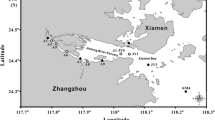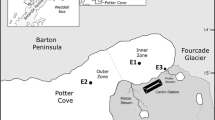Abstract
Guanabara Bay is an eutrophic estuarine system located in a humid tropical region surrounded by the second largest metropolitan area of Brazil. This study explores the contrasting environmental chemistry and microbiological parameters that influence the archaeaplankton diversity in a pollution gradient in Guanabara Bay ecosystem. The environments sampled ranged from completely anoxic waters in a polluted inner channel to the adjacent, relatively pristine, coastal Atlantic Ocean. Partial archaeal 16S rDNA sequences in water samples were retrieved by polymerase chain reaction (PCR) and analyzed using denaturing gradient gel electrophoresis (DGGE), cloning, and sequencing. Sequences were subjected to phylogenetic and diversity analyses. Community structure of the free-living archaeal assemblages was different from that of the particle-attached archaea according to DGGE. Gene libraries revealed that phylotype identification was consistent with environmental setting. Archaeal phylotypes found in polluted anoxic waters and in more pristine waters were closely related to organisms that have previously been found in these environments. However, inner bay archaea were related to organisms found in oil, industrial wastes, and sewage, implying that water pollution controls archaea communities in this system. The detection of a substantial number of uncultured phylotypes suggests that Guanabara Bay harbors a pool of novel archaeaplankton taxa.




Similar content being viewed by others
References
Acinas, SG, Klepac-Ceraj, V, Hunt, DE, Pharino, C, Ceraj, I, Distel, DL, Polz, MF (2004) Fine-scale phylogenetic architecture of a complex bacterial community. Nature 430: 551–554
Amann, RI, Stromley, J, Devereux, R, Key, R, Stahl, DA (1992) Molecular and microscopic identification of sulfate-reducing bacteria in multispecies biofilms. Appl Environ Microbiol 58: 614–623
Andrade, L, Gonzalez, AM, Araújo, FV, Paranhos, R (2003) Flow cytometry assessment of bacterioplankton in tropical marine environments. J Microbiol Methods 55: 841–850
Azam, F, Long, RA (2001) Sea snow microcosms. Nature 29: 497–498
Bano, N, Ruffin, S, Ransom, B, Hollibaugh, JT (2004) Phylogenetic composition of Arctic Ocean archaeal assemblages and comparison with Antarctic assemblages. Appl Environ Microbiol 70: 781–789
Béjà, O, Koonin, EV, Aravind, L, Taylor, LT, Seitz, H, Stein, JL et al (2002) Comparative genomic analysis of archaeal genotypic variants in a single population and in two different oceanic provinces. Appl Environ Microbiol 68: 335–345
Brito, EM, Guyoneaud, R, Goni-Urriza, M, Ranchou-Peyruse, A, Verbaere, A, Crapez, MA, Wasserman, JC, Duran, R (2006) Characterization of hydrocarbonoclastic bacterial communities from mangrove sediments in Guanabara Bay Brazil. Res Microbiol 57: 752–762
Casamayor, EO, Schafer, H, Baneras, L, Pedros-Alio, C, Muyzer, G (2000) Identification of and spatio-temporal differences between microbial assemblages from two neighboring sulfurous lakes: comparison by microscopy and denaturing gradient gel electrophoresis. Appl Environ Microbiol 66: 499–508
Clementino, MM, Fernandes, CC, Vieira, RP, Cardoso, AM, Polycarpo, CR, Martins, OB (2007) Archaeal diversity in naturally occurring and impacted environments from a tropical region. J Appl Microbiol. doi: 10.1111/j.1365-2672.2006.03230.x(in press)
Cole, JR, Chai, B, Marsh, TL, Farris, RJ, Wang, Q, Kulam, SA et al (2003) The Ribosomal Database Project (RDP-II): previewing a new autoaligner that allows regular updates and the new prokaryotic taxonomy. Nucleic Acids Res 31: 442–443
Cottrell, MT, Waidner, LA, Yu, L, Kirchman, DL (2005) Bacterial diversity of metagenomic and PCR libraries from the Delaware River. Environ Microbiol 7: 1883–1895
Crump, BC, Baross, JA (2000) Archaeaplankton in the Columbia River, its estuary and the adjacent coastal ocean USA. FEMS Microbiol Ecol 1: 231–239
DeLong, EF (1992) Archaea in coastal marine environments. Proc Natl Acad Sci USA 12: 5685–5689
DeLong, EF, Karl, DM (2005) Genomic perspectives in microbial oceanography. Nature 15: 336–342
Ewing, B, Hillier, L, Wendl, M, Green P (1998) Base-calling of automated sequencer traces using phred. I. Accuracy assessment. Genome Res 8: 175–185
Fuhrman, JA, Campbell, L (1998) Marine ecology: microbial microdiversity. Nature 393: 410–411
Fuhrman, JA, McCallum, K, Davis, AA (1992) Novel major archaebacterial group from marine plankton. Nature 356: 148–149
Giovannoni, SJ, Stingl, U (2005) Molecular diversity and ecology of microbial plankton. Nature 15: 343–348
Grasshoff, K, Kremling, K, Erhardt, M (1999) Methods of seawater analysis, 3rd edn. Wiley-VCH Verlag, Germany, 600 pp
Hagler, AN, Mendonça-Hagler, LC (1981) Yeast from marine and estuarine waters with different levels of pollution in the state of Rio de Janeiro Brazil. Appl Environ Microbiol 41: 173–178
Heck, Jr KL, van Belle, G, Simberloff, D (1975) Explicit calculation of the rarefaction diversity measurement and the determination of sufficient sample size. Ecology 56: 1459–1461
Hewson, I, Fuhrman, JA (2004) Richness and diversity of bacterioplankton species along an estuarine gradient in Moreton Bay Australia. Appl Environ Microbiol 70: 3425–3433
Hoch, MP, Kirchman, DL (1993) Seasonal and inter-annual variability in bacterial production and biomass in a temperate estuary. Mar Ecol Prog Ser 98: 283–295
Huang, X, Madan, A (1999) CAP3: a DNA sequence assembly program. Genome Res 9: 868–877
Hurlbert, SH (1971) The nonconcept of species diversity: a critique and alternative parameters. Ecology 52: 577–586
Karner, MB, DeLong, EF, Karl, DM (2001) Archaeal dominance in the mesopelagic zone of the Pacific Ocean. Nature 409: 507–510
Kimura, M (1980) A simple method for estimating evolutionary rates of base substitutions through comparative studies of nucleotide sequences. J Mol Evol 16: 111–120
Kirchman, DL, K’nees, E, Hodson, R (1985) Leucine incorporation and its potential as a measure of protein synthesis by bacteria in natural aquatic systems. Appl Environ Microbiol 49: 599–607
Könneke, M, Bernhard, AE, de la Torre, JR, Walker, CB, Waterbury, JB, Stah, DA (2005) Isolation of an autotrophic ammonia-oxidizing marine archaeon. Nature 437: 543–546
Kudo, Y, Nakajima, T, Miyaki, T, Oyaizu, H (1997) Methanogen flora of paddy soils in Japan. FEMS Microbiol Ecol 22: 39–48
Kumar, S, Tamura, K, Jakobsen, IB, Nei, M (2001) MEGA2: molecular evolutionary genetics analysis software. Bioinformatics 17: 1244–1245
Massana, R, DeLong, EF, Pedros-Alio, C (2000) A few cosmopolitan phylotypes dominate planktonic archaeal assemblages in widely different oceanic provinces. Appl Environ Microbiol 66: 1777–1787
Mayr, LM, Tenenbaun, DR, Villac, MC, Paranhos, R, Nogueira, CR, Bonecker, SLC, Bonecker, AC (1989) Hydrobiological characterization of Guanabara Bay Coastlines of Brazil. American Society of Civil Engineers 1: 124–139
Meniconi, MDG, Gabardo, IT, Carneiro, MER, Barbanti, SM, Cruz da Silva, G, Massone, CG (2002) Brazilian oil spills chemical characterization. International Society of Environ Forensics 3: 303–321
Muyzer, G, DeWaal, EC, Uitterlinden, AG (1993) Profiling of complex microbial populations by denaturing chain reaction-amplified genes-coding for 16S Ribosomal-RNA. Appl Environ Microbiol 59: 695–700
Murray, AE, Preston, CM, Massana, R, Taylor, LT, Blakis, A, Wu, K, DeLong, EF (1998) Seasonal and spatial variability of bacterial and archaeal assemblages in the coastal waters near Anvers Island Antarctica. Appl Environ Microbiol 64: 2585–2595
Paranhos, R, Pereira, AP, Mayr, LM (1998) Diel variability of water quality in a tropical polluted bay. Environ Monit Assess 50: 131–141
Parsons, TR, Maita, Y, Lalli, CM (1984) A manual of chemical and biological methods for seawater analysis. Oxford Pergamon Press, 173 pp
Rappe, MS, Giovannoni, SJ (2003) The uncultured microbial majority. Annu Rev Microbiol 57: 369–394
Robertson, CE, Harris, JK, Spear, JR, Pace, NR (2005) Phylogenetic diversity and ecology of environmental Archaea. Curr Opin Microbiol 8: 638–642
Saitou, N, Nei, M (1987) The neighbour-joining method: a new method for reconstructing phylogenetic trees. Mol Biol Evol 4: 406–425
Schleper, C, Jurgens, G, Jonuscheit, M (2005) Genomic studies of uncultivated Archaea. Nat Rev Microbiol 3: 479–488
Somerville, CC, Knight, IT, Straube, WL, Colwell, RR (1989) Simple rapid method for direct isolation of nucleic acids from aquatic environments. Appl Environ Microbiol 55: 548–554
Thompson, JD, Gibson, TJ, Plewniak, F, Jeanmougin, F, Higgins, DG (1997) The ClustalX windows interface: flexible strategies for multiple sequence alignment aided by quality analysis tools. Nucleic Acids Res 24: 4876–4882
Valentin, JL (1984) Analysis of hidrobiological parameters in the Cabo Frio (Brazil) upwelling. Mar Biol 82: 259–276
Zeng, Y, Li, H, Jiao, N (2007) Phylogenetic diversity of planktonic archaea in the estuarine region of East China Sea. Microbiol Res 162: 26–36
Acknowledgments
We acknowledge Genome Sequencing facilities core Johanna Döbereiner, IBqM/UFRJ, Limnology Laboratory of UFRJ for the access to liquid scintillator and officers and crew of OV Astro Garoupa. We are grateful to PETROBRAS and Astromarítima for kindly providing ship time and fuel. We also thank Leonardo Cesar A. da Silva for his valuable help with Rarefaction analysis program. We are grateful to Fernando N. Pinto for sample collection and Guilherme R. S. Muricy for manuscript review. We also thank Laboratory of Ecology and Taxonomy of Microorganisms IMPPG/UFRJ for DGGE facilities. This work was supported by a FAPERJ grant (150.121/04); RHAE—PUC; Pronex 171.177/03 (CNPq/FAPERJ); Finep/CTPetro No. 21.01.0278.00.
Author information
Authors and Affiliations
Corresponding author
Rights and permissions
About this article
Cite this article
Vieira, R.P., Clementino, M.M., Cardoso, A.M. et al. Archaeal Communities in a Tropical Estuarine Ecosystem: Guanabara Bay, Brazil. Microb Ecol 54, 460–468 (2007). https://doi.org/10.1007/s00248-007-9261-y
Received:
Accepted:
Published:
Issue Date:
DOI: https://doi.org/10.1007/s00248-007-9261-y




